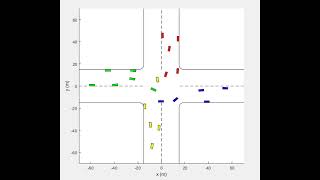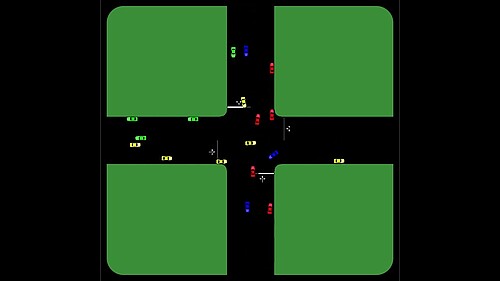Video Playlist 17: Lane-free signal-free intersection crossing via Model Predictive Control
The videos included in this playlist are a part of the results presented in the papers titled “Optimal control of automated vehicles crossing a lane-free signal-free intersection”, European Control Conference (ECC) 2024, and “Lane-free signal-free intersection crossing via model predictive control”, Control Engineering Practice. Two Model Predictive Control (MPC) schemes are developed to manage CAVs crossing signal-free and lane-free intersections. In fact, the control inputs of all vehicles are optimized over a time-horizon by online solving of a joint optimal control problem (OCP) that minimizes a cost function including proper terms to ensure smooth and collision-free vehicle motion, while also considering fuel consumption and desired-speed tracking, when possible. Additionally, appropriate constraints are designed to respect the intersection boundaries and ensure smooth vehicle movements towards their respective destinations.
Multiple simulation experiments are carried out to assess the efficiency and practicality of the proposed methods. In all experiments, the vehicles bound to each specific destination are depicted in a corresponding color, regardless their origin. Geometrical intersection and vehicle data (dimensions, desired speeds, physical limits, etc.) are provided in the papers.
Open-loop optimal control (ECC 2024)
This video illustrates the results of applying the optimal control approach to 21 vehicles crossing a signal-free intersection. As seen, vehicles with all possible ODs drive towards their respective destinations simultaneously without collisions, featuring smooth and fast motion and remaining within the intersection boundaries. The physical limits of control inputs, i.e. acceleration and steering angle, are always satisfied.

Open-loop optimal control (Control Engineering Practice)
The video presents the results obtained by implementing the open-loop optimal controller in the same scenario as the previous video, but with modified control settings outlined in the journal paper. In particular, the sampling period is doubled to reduce the computational time, and the cost function weights are re-tuned.

Model Predictive Control Scheme 1
This video illustrates the results of applying the first MPC strategy to 400 vehicles continuously crossing a signal-free intersection. Symmetric flows from all branches are considered, and the turning rates for left and right-turning vehicles are 0.25 each. In this method, the joint optimal control problem is solved every 2 seconds, encompassing vehicles within the Extended Crossing Area (ECA), in order to determine vehicle control trajectories for a time horizon of 4 s. Each vehicle is optimized several times until it leaves the ECA. As can be observed, vehicles continuously approaching the intersection are smoothly and safely guided towards their destinations without violating the boundaries.

Model Predictive Control Scheme 2
The provided video shows visually the outcome of employing the second MPC in the same conditions as the previous video. In the second MPC strategy, the OCP is again solved every 2 seconds, but now only for newly entered vehicles; while the other vehicles within OCZ retain their computed trajectories and are treated as moving obstacles for the newly entered vehicles in the OCP. This implies that each vehicle is optimized only once. This control scheme can also properly handle vehicles crossing the intersection, as shown in the video.

Moderate turning rates
Description: The final experiment corresponds to a scenario where right and left turning rates are more moderate, 0.1, and we employ the first MPC scheme. As seen in the video, under these circumstances, vehicles experience significantly fewer conflicts, which leads to reduced crossing time. The proposed scheme effectively manages demands of up to 8.800 veh/h, which is very high for urban intersections, without causing any significant delays.

